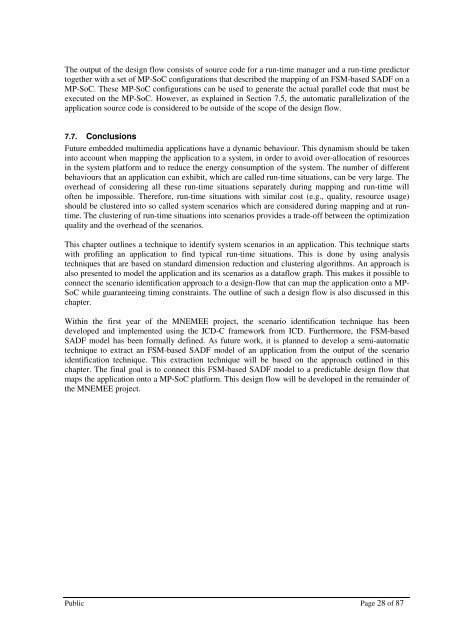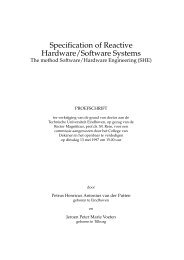MNEMEE - Electronic Systems - Technische Universiteit Eindhoven
MNEMEE - Electronic Systems - Technische Universiteit Eindhoven
MNEMEE - Electronic Systems - Technische Universiteit Eindhoven
You also want an ePaper? Increase the reach of your titles
YUMPU automatically turns print PDFs into web optimized ePapers that Google loves.
The output of the design flow consists of source code for a run-time manager and a run-time predictor<br />
together with a set of MP-SoC configurations that described the mapping of an FSM-based SADF on a<br />
MP-SoC. These MP-SoC configurations can be used to generate the actual parallel code that must be<br />
executed on the MP-SoC. However, as explained in Section 7.5, the automatic parallelization of the<br />
application source code is considered to be outside of the scope of the design flow.<br />
7.7. Conclusions<br />
Future embedded multimedia applications have a dynamic behaviour. This dynamism should be taken<br />
into account when mapping the application to a system, in order to avoid over-allocation of resources<br />
in the system platform and to reduce the energy consumption of the system. The number of different<br />
behaviours that an application can exhibit, which are called run-time situations, can be very large. The<br />
overhead of considering all these run-time situations separately during mapping and run-time will<br />
often be impossible. Therefore, run-time situations with similar cost (e.g., quality, resource usage)<br />
should be clustered into so called system scenarios which are considered during mapping and at runtime.<br />
The clustering of run-time situations into scenarios provides a trade-off between the optimization<br />
quality and the overhead of the scenarios.<br />
This chapter outlines a technique to identify system scenarios in an application. This technique starts<br />
with profiling an application to find typical run-time situations. This is done by using analysis<br />
techniques that are based on standard dimension reduction and clustering algorithms. An approach is<br />
also presented to model the application and its scenarios as a dataflow graph. This makes it possible to<br />
connect the scenario identification approach to a design-flow that can map the application onto a MP-<br />
SoC while guaranteeing timing constraints. The outline of such a design flow is also discussed in this<br />
chapter.<br />
Within the first year of the <strong>MNEMEE</strong> project, the scenario identification technique has been<br />
developed and implemented using the ICD-C framework from ICD. Furthermore, the FSM-based<br />
SADF model has been formally defined. As future work, it is planned to develop a semi-automatic<br />
technique to extract an FSM-based SADF model of an application from the output of the scenario<br />
identification technique. This extraction technique will be based on the approach outlined in this<br />
chapter. The final goal is to connect this FSM-based SADF model to a predictable design flow that<br />
maps the application onto a MP-SoC platform. This design flow will be developed in the remainder of<br />
the <strong>MNEMEE</strong> project.<br />
Public Page 28 of 87
















